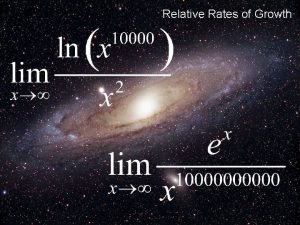Relative Rates of Growth The function grows very












- Slides: 12

Relative Rates of Growth

The function grows very fast. We could graph it on the chalkboard: If x is 3 inches, y is about 20 inches: We have gonethe less than half At 64 inches, y-value -way the edge boardof the wouldacross be at the horizontally, and already the known universe! y-value would reach the (13 billion light-years) Andromeda Galaxy!

The function grows very slowly. If we graph it on the chalkboard it looks like this: We would have to move 2. 6 miles to the right before the line moves a foot above the x-axis! 64 inches By the time we reach the edge of the universe again (13 billion light-years) the chalk line will only have reached 64 inches! The function increases everywhere, even though it increases extremely slowly.

Definitions: Faster, Slower, Same-rate Growth as Let f (x) and g(x) be positive for x sufficiently large. 1. f grows faster than g (and g grows slower than f ) as if or 2. f and g grow at the same rate as if

Grows faster than any polynomial function. ln x Grows slower than any polynomial function.

WARNING Careful about relying on your intuition.

According to this definition, than. does not grow faster Since this is a finite non-zero limit, the functions grow at the same rate! The book says that “f grows faster than g” means that for large x values, g is negligible compared to f. “Grows faster” is not the same as “has a steeper slope”!

“Growing at the same rate” is transitive. In other words, if two functions grow at the same rate as a third function, then the first two functions grow at the same rate.

Show that the same rate as and grow at . f and g grow at the same rate.

Show that same rate as grows faster than grows at the

Order and Oh-Notation Definition f of Smaller Order than g Let f and g be positive for x sufficiently large. Then f is of smaller order than g as if We write Saying slower than g. and say “f is little-oh of g. ” is another way to say that f grows

Order and Oh-Notation Definition f of at Most the Order of g Let f and g be positive for x sufficiently large. Then f is of at most the order of g as if there is a positive integer M for which for x sufficiently large We write and say “f is big-oh of g. ” Saying is another way to say that f grows no faster than g. p
 Growth is defined as an increase in
Growth is defined as an increase in Relative rates of growth
Relative rates of growth A rate is a ratio that compares
A rate is a ratio that compares Equivalent ratios guided notes
Equivalent ratios guided notes Ratios rates and unit rates
Ratios rates and unit rates Ratios rates and unit rates
Ratios rates and unit rates Interest rates and economic growth
Interest rates and economic growth Very bad to very good scale
Very bad to very good scale Scientific notation rules
Scientific notation rules Very little or very few
Very little or very few Is a very shallow skillet with very short sloping sides
Is a very shallow skillet with very short sloping sides Quantifiers for food
Quantifiers for food Root hair structure
Root hair structure























